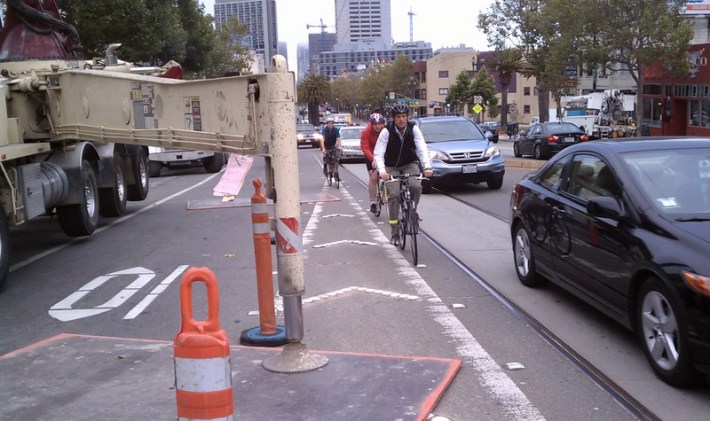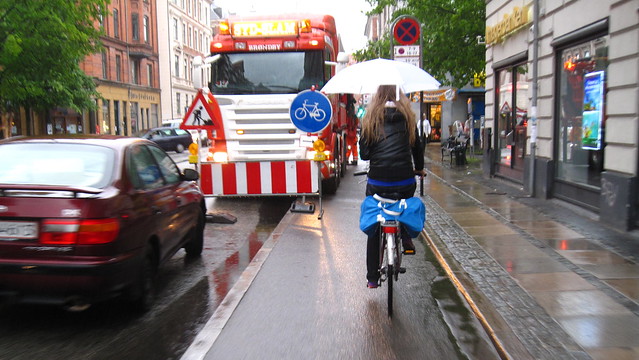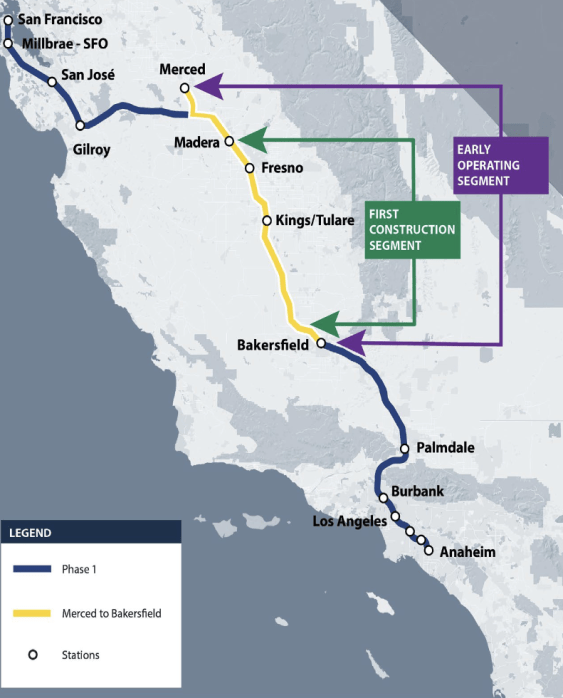During Construction, the Safety of People on Bikes Is Dispensable
2:17 PM PDT on August 8, 2012
We recently wrote about the benefits to bicycle riders that come from temporarily removing car parking at construction sites. But there are other times when construction can do just the opposite, throwing them into harm's way.
At the very same construction site at 1844 Market Street, where we pointed out that parking removal had improved conditions for bicycle commuters climbing the hill to the Wiggle, crews last Friday set up a dangerous and perplexing labyrinth for evening rush hour bicycle traffic. To make room for what appeared to be a concrete pouring machine, the parking, bicycle, and right-most traffic lanes were closed, leaving no choice but to merge into a lane with car traffic and trolley tracks, or, as most bike commuters chose, to delicately negotiate the extremely narrow space between the trolley tracks and reflective road bumps.
Residents of any major city are used to putting up with inconveniences for construction. But in this all-too-common situation, people were thrown into dangerous conditions with virtually no guidance about how to pass safely aside from a sign reading, "Bikes allowed use of full lane" (even if the lane has tracks, that's apparently all that's required by law [PDF]). The sidewalk was also closed, with vague signage asking pedestrians to detour to the other side of the street, leading some to walk in the road.

While I'm no engineer, the safer solution here didn't appear obvious. It's not easy to safely accommodate all modes during construction, but it can be done.
Compare this level of consideration with that found in Copenhagen. In a post on Copenhagenize last year, Mikael Colville-Andersen wrote that maintaining safe passage for people on bicycles is mandatory at construction sites, and that "the City prioritises the bicycle traffic wherever possible in such situations."
It doesn't make much sense to build bicycle infrastructure and then not keep it clear. Roads are swept or cleared of snow, as are sidewalks. The same applies to bicycle lanes and tracks. The bicycles must roll on. In a city with such high levels of bicycle traffic, restricting their movement would be expensive. For example, thousands of people late for work means lost manhours for the economy...
A city must send concrete signals that it takes bicycle traffic seriously. Cycling citizens need a city that is reliable in its maintenance and prioritisation of bicycles. If they can count on their infrastructure being taken care of, it will encourage them to ride. If trains, for example, are unreliable, fewer people will use them and look to other modes. The same applies to bicycle traffic. Rain or snow. Roadworks or smooth sailing. 24-7.
If you drive to work in San Francisco, you can expect to face some delays and detours at a construction site, but you will probably never feel that the arrangement actually puts your life in danger.
Even during rush hour on Market, the street most heavily traveled by bike, this is one more instance in which the city's lack of consideration signals to its citizens that the choice to ride a bike will be met with peril.
Stay in touch
Sign up for our free newsletter





